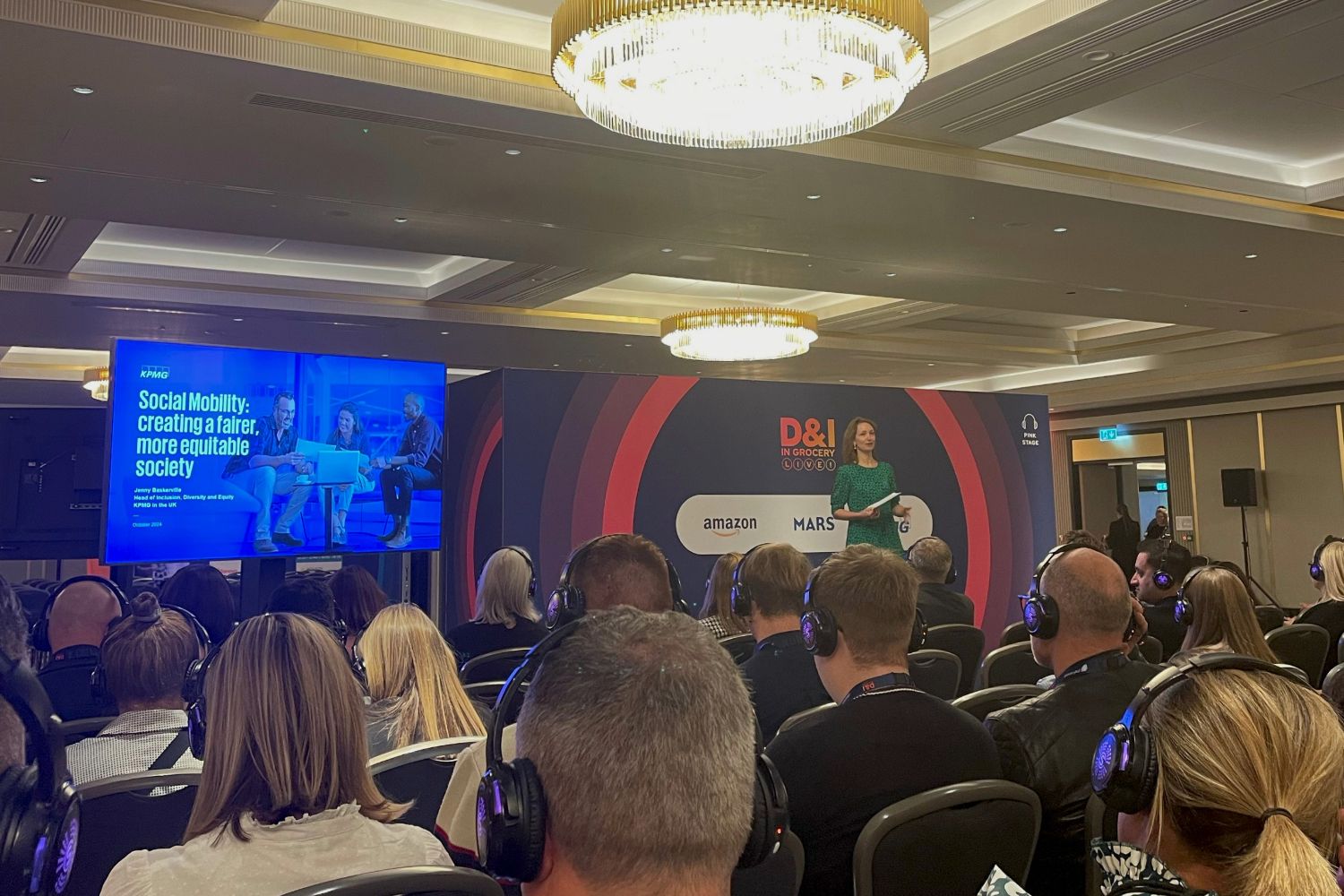Supported by KPMG for the third year in a row, D&I in Grocery LIVE! brought together more than 1,300 of the industry’s champions, allies and changemakers in inclusion, diversity and equity (IDE). Our UK head of IDE, Jenny Baskerville, explored the ways in which we support social mobility to create a fairer and more equitable workplace. She shared her advice on how leaders can promote social mobility within their own organisations.

Firsts in IDE: Embedding socio-economic diversity into our business
The most robust measure of socio-economic background is the job held by your highest-earning parent or carer when you were 14 (your ‘parental occupation’). Ultimately, where you start out should not define where you end up. At KPMG we’re committed to creating an inclusive environment where all colleagues thrive and reach their full potential, whatever their identity or background.
Back in 2016, KPMG began capturing and measuring the socio-economic background of its employees. We were the first organisation to share that data, and we’ve continued to publish it ever since. It was, effectively, the start of the journey to embed socio-economic diversity into our HR and talent processes, and into the entire employee lifecycle.
In 2021, KPMG became the first organisation to publish our socio-economic background pay gaps. And we were the first to set a bold socio-economic diversity ambition for our senior management, to sit alongside our other publicly declared targets on gender, ethnicity, disability and sexual orientation. By 2030, we aim for 29 percent of our partners to come from lower socio-economic backgrounds. Targets like this hold us accountable, both internally and publicly, for delivering meaningful change.
Our Mind the Gap report in 2022 delivered a wake-up call, not just to KPMG but right across sectors and industries. Quantitative research, in partnership with the Bridge Group, involving 16,500 KPMG colleagues examined how long it takes to get promoted, considering characteristics such as gender, ethnicity, disability, sexual orientation and socio-economic background. It found that people from the lowest socio-economic backgrounds take on average 19 percent more time to progress to the next grade than their peers. Furthermore, white females from lower socio-economic backgrounds have the slowest rate of progression. They take 32 percent more time to progress than Asian males from higher socio-economic backgrounds, who progress fastest.
Today, across sectors, and through membership body Progress Together, where Jenny serves as a non-exec director, efforts to improve socio-economic diversity in senior roles are being made. At KPMG, our social mobility employee network and focus groups help to identify key issues and what we need to do to resolve them. We’re committed to delivering an inclusive environment, creating accountable leadership and providing equitable experiences — paving the way to a fairer future for all.
Talent attraction: How to make your business accessible
There are talented people who might not be familiar with your business. If you are to attract, recruit and retain individuals from lower socio-economic backgrounds, you must have an intentional and active attraction strategy. One way to do this is through partnerships with communities, schools and colleges.
KPMG initiatives include our Discovery Work Experience Programme for those who have finished Year 13 or are looking to start an apprenticeship and our Social Mobility Talent Insight Programme for undergraduates, which can lead to summer internships and places on our graduate schemes. For those interested in an alternative pathway, our apprenticeship programme is an excellent route into our firm, providing equal opportunities for career progression.
Once on board, our IDE talent development programmes help to level the playing field, offering individuals support with their professional growth. Our Reach Programme, for instance, is designed for our middle management — a group that is currently less socio-economically diverse than we would like — to help them navigate the promotion process.
Across our firm, IDE learning is now mandatory, making social mobility better understood and helping to dispel misconceptions. Our continued ambition is to ensure social mobility is core to both our IDE strategy and our overall business strategy.
Fix the systems, not the people
For Jenny, being successful in IDE is not about fixing people. Rather it is about rooting out inequity within systems and processes.
So, when you are deciding on promotions, for instance, overlay IDE data, including parental occupation data, on top of performance, salary and bonus data. And look for potential system issues that need to be rectified to support greater social mobility.
And it’s important to look at processes, such as work allocation, to assess whether the type of work allocated may limit an individual’s progression. At KPMG, we’re now using technology and behavioural frameworks to reshape how we typically allocate work, enabling us to manage processes in a more effective and productive way.
How can leaders enable social mobility?
If we were starting our IDE journey from scratch, here’s how we would approach it:
- Engage leadership on IDE, but also the people who experience and understand the barriers that limit social mobility. Build networks.
- Be clear and set ambitions. And make sure you are all pointing in the same direction.
- Turn insight, whether qualitative or quantitative, into action. And share those learnings.
- Build accountability. Leadership is responsible for driving change.
- Include a feedback loop to pinpoint what’s working and what’s not.
- Communicate. Constantly.
Get involved: Cross-Company Social Mobility Programme
Our research reveals that middle management faces some of the biggest barriers to career progression. So, we’re inviting you to join us on our Cross-Company Social Mobility Programme.
This six-month programme pairs middle managers from two organisations in a peer-mentor relationship, creating opportunities to learn from each other, share work-based experiences and provide challenge and support.
Our Cross-Company Social Mobility Programme goes live in January 2025, and you can sign up here for more information.





